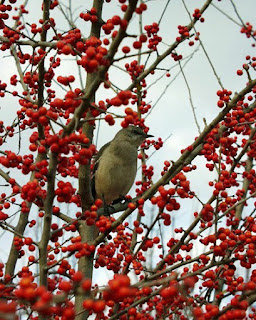Although I do plant in my garden plants that please me, I usually garden with little animals in mind. Birdwatching really does bring alot of joy to my family. We enjoy watching the little birds flitting around, grabbing seeds, diving at each other with their territorial antics, and such. Most of our native birds are very beautiful, and my favorites are the little chickadees! Also, it tickles us to hear the sound the doves make when they fly up to a tree branch.
And, although I hear many complaints from others about the squirrels, I don't mind that they eat so much of the birdseed. It's worth it to us, for the fun we get out of watching them try to get a little snack before Shadow, our very large black lab, notices them.
It probably doesn't surprise you that when I choose new plants for the garden, I look for something that will help me out with expenses--I try to plant shrubs and trees that will make berries and fruits for the wildlife creatures to eat, thus saving me a little bit in the cost of birdseed and corn. Some of the plants we use are common, but every little bit helps!
It probably doesn't surprise you that when I choose new plants for the garden, I look for something that will help me out with expenses--I try to plant shrubs and trees that will make berries and fruits for the wildlife creatures to eat, thus saving me a little bit in the cost of birdseed and corn. Some of the plants we use are common, but every little bit helps!
- Holly is a dependable plant for berries each winter. The evergreen hollies with which we're all so familiar are great, but my favorite is our native Possumhaw Holly, Ilex decidua. The shiny red berries really stand out against a winter background, the mottled gray and white bark is lovely in all seasons, and the tree is constantly full of birds during the winter.
- Dogwood provides showy fruit in either red or white, depending on the species you plant.
- Viburnums are available in both deciduous and evergreen species, but my favorites are the Cranberry and Arrowwood Viburnums. They're native to the US and provide plenty of colorful berries. Plant several of each for good berry production.
- Blueberries are devoured quickly by the lucky one who finds them first, so plant as many shrubs as possible, and you'll need more than 1 variety for cross-pollination.
- Mahonia, although not a native plant, is a wonderful addition to the winter garden, since the bright yellow blooms appear in January and develop into purple berries in late winter and early spring when all the other berries have been eaten.
So as you add to your garden, plant some of these berry-producing shrubs near a window so you can see the birds and squirrels, and I promise you, you'll find yourself smiling as you watch them.





No comments:
Post a Comment